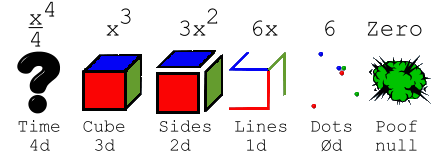| (4/3)Pi 13
---------------- |
= | 1
--------------------- |
= | one
quadrillionth |
Quantum Math
When we differentiate, we get the instantaneous change in whatever equation or shape we consider.
It's easy to visualize because the starting equation or figure, for instance a 3-dimensional cube
So, this means to instantaneously increase volume, tack on area to half the outside surface.
Taking this one step further
 we arrive at
we arrive at
Every plane needs two lines (length and width) to increase its area. Three planes times two lines equals six lines total.
Now it gets even easier... six points
Now we arrive at
A big problem occurs when we try to integrate something cubic
The Cube isn't Solid. Nothing is Solid
 Remember, nothing is even remotely solid. So you will rack your brain trying to visualize the integration of a solid or in this case an actual misconception.
The mysterious fourth dimensional shape is a tetrahedral axes shaped particle group of higher density.
Remember, nothing is even remotely solid. So you will rack your brain trying to visualize the integration of a solid or in this case an actual misconception.
The mysterious fourth dimensional shape is a tetrahedral axes shaped particle group of higher density.
Any one dimensional object is a line. Any two dimensional object is a plane. But that's a slice of a supposed cube, and can't be thought of as for instance a sheet of paper. Because, if we integrate enough of them into a stack, we have a solid cube of paper and by now we know nothing is solid.
Nothing is Solid.
The cube can't be solid. So that form of thinking
is simply wrong (note: The one dimensional line would also have to be in segments, and although we can actually integrate lines into a plane ... the lines in this case are never arranged parallel so they won't form a continuous plane that could then be integrated into a stack)...
The cube isn't solid but since it is there, it must be made of something.
If we call the basic unit of whatever the cube is comprised of a particle.
The particle must be capable of conveying information, for instance electro - magnetic vibrations.
And since there are different frequencies and / or strengths of vibrations with multiple simultaneous combinations, a zero-dimensional single point particle would be incapable of achieving this. It can spin or move or remain at rest but there is no chance of Simultaneity or vibrations. The next possible alternative is the one dimensional line or thread (any intrinsic universal characteristic will always be the simplest and at the same time most efficient option).
The thread or string seems to be the shape of choice in this case. On a musical instrument, a violin for instance, the string can convey a multitude of vibrations, tones and harmonics. This means there can be a lot of simultaneous information transmitted along a one dimensional string. There is no need to attempt theoretical construction of a particle made of two dimensional planes because... you don't keep looking for the answer after you have found it. And, if we integrate enough of the planes into a stack, we would have a solid. Nothing is Solid.
Particle Integration:
| x4/4 = 1/4 tessarea = 4 axis (? time)
x3 = 1 volume = 3 axis x 1 3x2 = 3 area = 2 axis x 3 6x = 6 lines = 1 line x 6 |
 this is 3 plus signs or XY axes shaped particles that each have 2 axis with a total length of 6 and an area of 3, that makes 6 axis with 1 length each. This is also the correct amount to add one quadratic particle XY to every axis of the original differentiated particle giving the XYZ an instantaneous change.
this is 3 plus signs or XY axes shaped particles that each have 2 axis with a total length of 6 and an area of 3, that makes 6 axis with 1 length each. This is also the correct amount to add one quadratic particle XY to every axis of the original differentiated particle giving the XYZ an instantaneous change. 
Spatial dimension is directions.
An Abbott Flatlander from Flatland living on a two dimensional plane would actually be living on an infinity of dimensions  if he can turn or move through every angle or vector direction on the supposed plane.
The way this actually works is by using axial directions as dimension.
if he can turn or move through every angle or vector direction on the supposed plane.
The way this actually works is by using axial directions as dimension.
An actual working two dimensional model of space would be an infinite array of
The actual
So,
This axial concept allows for an actual visual of higher dimensions. If we integrate a supposed three-dimensional cube into the fourth dimension the result isn't a snapshot of the cube in the fourth dimension, it is a tetrahedron with an increased density field matrix (tetrahedral).
You have to remember... nothing is
A proton is
So if you want to bump up one dimension higher than the dimension you actually see things in, you're going to have to contemplate a mysterious visitor from the eleventh dimension (not the fourth).
If you want to bump up something in dimension until it is actually solid... you're on your way to creating your very own neutron star with a contiguous proton/neutron pack, We're all in trouble if we get a visit from one of them.
Quantum Weirdness:
Everything might be actually happening very, very slowly. Since everything involved in the continuum structure is completely controlled or regulated at the speed of light (including Stars, Planets, any type of measuring device, Plants, Animals, Humans and everything else, excluding for instance neutrinos), we have no way of knowing what speed things are really happening.
It's like being a character in a movie, you are just film and you are trying to find out what speed the projector is running.
If you could take a step out and away, literally remove yourself from everything and look back at what's happening, The movie might run fast, slow, even stop and start and no one would be the wiser. There would be no way for the people still in the movie to discern this. The movie would be their whole universe, their very existence.
The speed the projector is running is the speed their lives are happening.
The Speed of light and all particle interactions might be traveling or happening at the pace of an Escargot (snail) but our brains are using the same speed vibration set by this cosmic speedometer so we'll never know.
|
|
|
The particle itself would be just the grey threads in the picture (no color and a lot thinner of course).
It would fit perfectly inside of a dodecahedron. Actual thread length is about one Ångström and it is fine enough where 10 threads (20 radii) could curl-up into the size of a neutron.
10-power-of-120
18-determinate-number automatic-arrangement blunders.php dark-matter.php einstein-did-not-say-that energy-is-not-equal-to-mass gravitational-warpage gravity-is-not-a-weak-force how-energy-actually-works inadvertently-correct intermittent-photon-exchange isotopes math matter-cannot-be-fat quantum-glue quantum-string-math quarks spatial-expansion stationary-ether tesla.php ghost-in-the-machine one-inch-equation time truth what-is-space-time what-powers-a-black-hole why-the-speed-of-light-is-c |